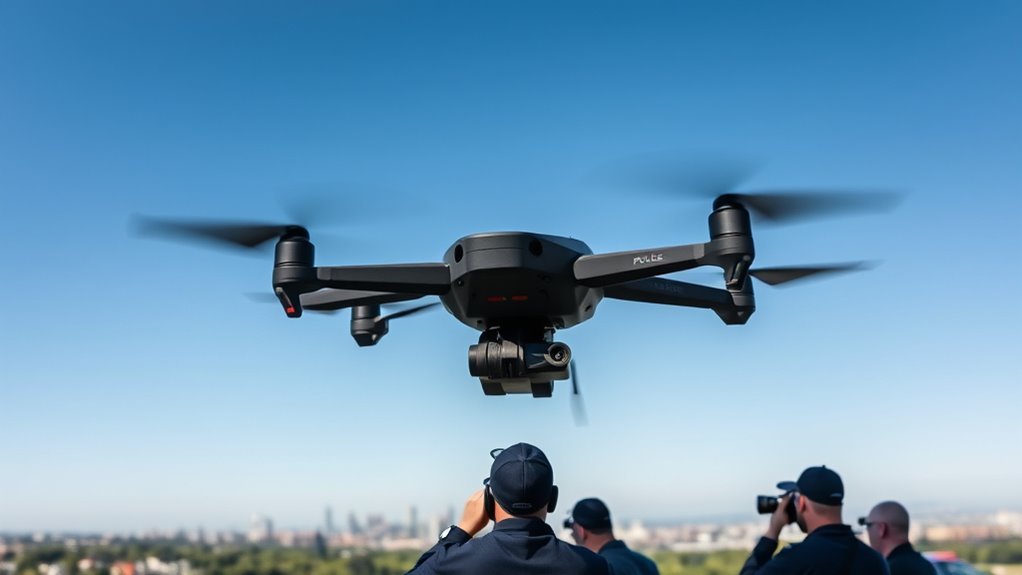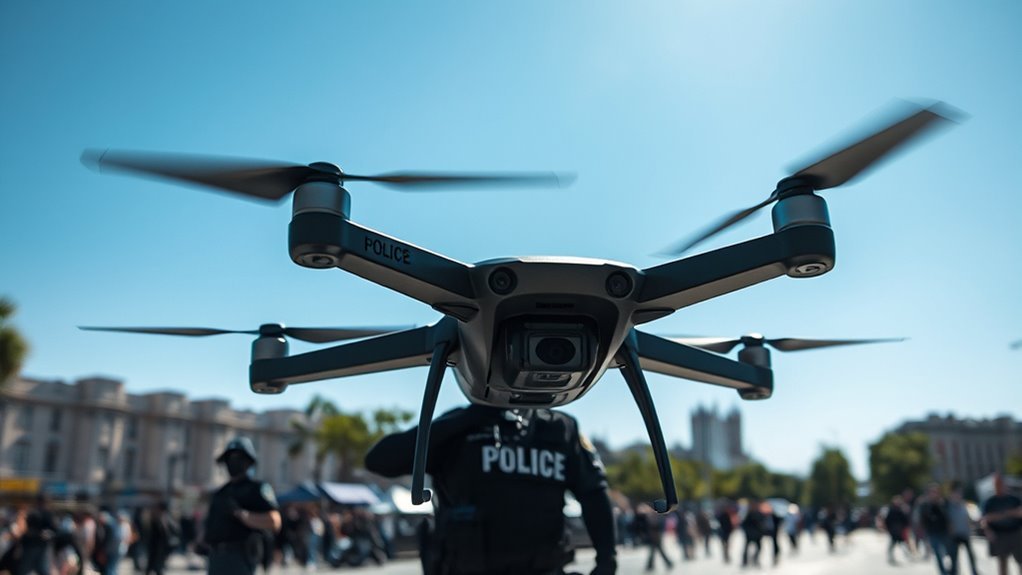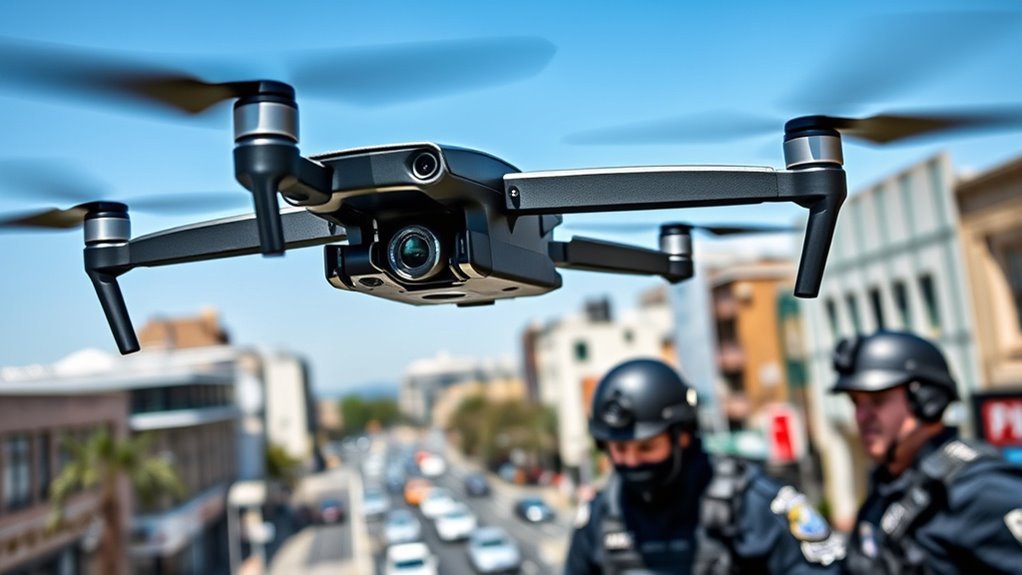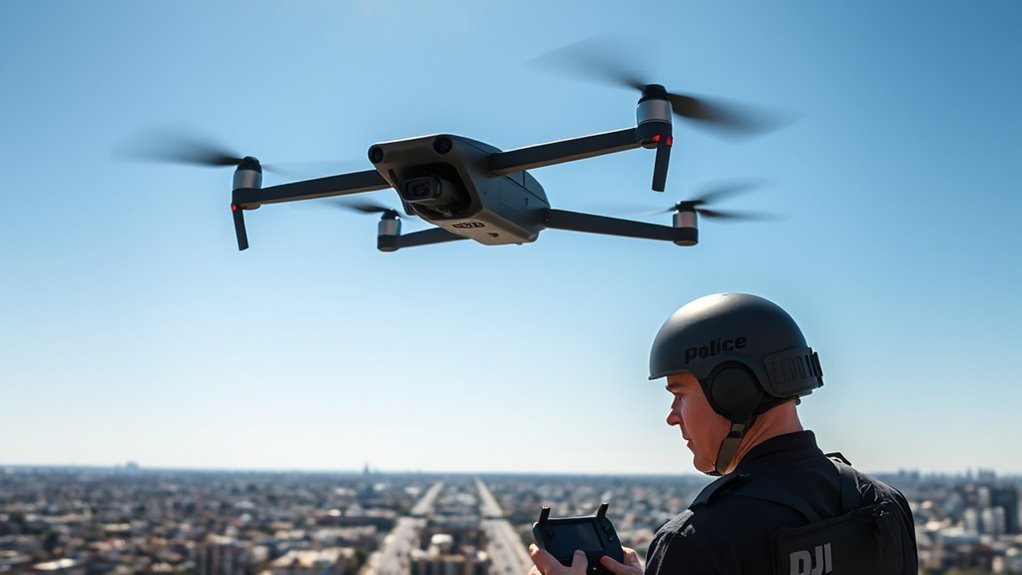Police most commonly use fixed-wing, multirotor, and hybrid drones, each tailored for specific operational roles. Fixed-wing drones excel in covering large areas for aerial mapping. Multirotor drones offer excellent maneuverability, making them ideal for tight situations. Hybrid drones combine the best features of both types, delivering enhanced capabilities. Additionally, thermal imaging drones aid in various specialized applications. If you’re interested in the unique applications and technologies behind these drones, there’s even more to discover.
Overview of Police Drone Technology

As law enforcement agencies increasingly adopt advanced technologies, police drone technology has emerged as a critical tool for enhancing public safety and operational efficiency. You’ll find that drone advancements allow for real-time surveillance, evidence collection, and support during critical incidents. These unmanned aerial vehicles provide an aerial perspective, enabling officers to assess situations without endangering lives. Additionally, drones equipped with real-time aerial surveillance capabilities enhance the ability to track movements and identify hazards swiftly.
Moreover, law enforcement can deploy drones for search and rescue missions, crime scene analysis, and monitoring large events. The integration of high-definition cameras and thermal imaging enhances situational awareness, while GPS capabilities improve coordination. By leveraging these technologies, law enforcement can operate more effectively, ensuring community safety while respecting civil liberties. Understanding these applications is essential for appreciating the balance between innovation and freedom. Additionally, advanced technology innovations empower drones to deliver rapid data transmission, ensuring preparedness in high-stakes scenarios.
Fixed-Wing Drones

Fixed-wing drones represent a significant advancement in police aerial technology, offering unique capabilities that distinguish them from their multi-rotor counterparts. With their fixed wing capabilities, these drones can cover vast areas efficiently, making them ideal for large-scale operations such as search and rescue or crime scene investigations. Their extended flight times allow for sustained surveillance, reducing the need for frequent recharging. In addition, fixed-wing drones excel in aerial mapping, providing high-resolution imagery that can assist in crime analysis and strategic planning. This technology not only enhances situational awareness but also supports law enforcement in making informed decisions, ultimately empowering communities to maintain safety and security without compromising individual freedoms. Moreover, advanced sensor technology equips these drones with high-resolution payloads, delivering precise data crucial for effective policing. The use of battery life in fixed-wing drones allows for longer aerial missions compared to traditional drones, enhancing operational capabilities.
Multirotor Drones

Multirotor drones have transformed police operations by offering remarkable versatility and maneuverability. Utilizing advanced multirotor technology, these drones can hover, ascend, and descend rapidly, making them ideal for various law enforcement scenarios. You’ll find that their compact size allows for deployment in tight spaces, enhancing situational awareness during critical incidents. Equipped with high-resolution cameras, they excel in aerial photography, providing real-time visual data for surveillance, crowd management, and crime scene documentation. This capability not only increases operational efficiency but also promotes transparency and accountability in policing. As these drones continue to evolve, you’ll see them playing an even more pivotal role in maintaining public safety while respecting individual freedoms. Their adaptability truly makes them invaluable tools for modern law enforcement. Additionally, many police drones are designed with enhanced safety features to prevent accidents and ensure safer operations in urban environments. These advanced safety features enhance operational reliability by detecting and mitigating risks in real time.
Hybrid Drones
The introduction of hybrid drones in law enforcement combines the advantages of both multirotor and fixed-wing designs, offering enhanced operational capabilities. These drones leverage hybrid technology to provide exceptional drone versatility, allowing for extended flight times and varied mission profiles. By integrating vertical takeoff and landing (VTOL) abilities with efficient long-range flight, they’re revolutionizing aerial policing. Additionally, these drones can enhance real-time threat detection and situational awareness during various operations, further supporting law enforcement efforts. Moreover, the integration of thermal imaging technology enhances the ability to detect heat signatures, providing crucial insights in low-visibility conditions.
| Feature | Multirotor Drones | Fixed-Wing Drones | Hybrid Drones |
|---|---|---|---|
| Flight Time | Short (20-30 min) | Long (up to 2 hrs) | Moderate (up to 1 hr) |
| Payload Capacity | Limited | High | Moderate |
| Operational Range | Limited | Extensive | Flexible |
| Deployment Speed | Quick | Slower | Fast |
This blend of functionalities empowers law enforcement agencies to adapt swiftly in various scenarios, enhancing public safety and operational efficiency.
Thermal Imaging Drones
Thermal imaging drones represent a significant advancement in law enforcement capabilities, particularly in low-light and challenging weather conditions. These drones utilize thermal detection capabilities to identify heat signatures, allowing officers to locate individuals or vehicles that may not be visible through conventional surveillance methods. During nighttime operations, this technology becomes invaluable, enabling real-time monitoring of situations that traditional lighting would fail to illuminate. By deploying thermal imaging drones, police can enhance their situational awareness, improving response times and operational efficiency. This capability not only aids in the apprehension of suspects but also helps in evaluating crowd dynamics and managing public safety. Ultimately, the integration of these drones exemplifies a commitment to utilizing advanced technology in the pursuit of preserving freedom and security.
Drones for Search and Rescue
Utilizing drones for search and rescue operations greatly enhances the efficiency and effectiveness of these missions. By integrating advanced search techniques, drones provide critical support to responders in locating missing persons quickly. You can imagine the emotional weight these operations carry, as drones help save lives.
- They cover vast areas in minutes, reducing search time considerably.
- Equipped with high-resolution cameras, they provide real-time visuals, allowing teams to assess situations with precision.
- Drones can access hard-to-reach locations, ensuring no one is left behind. Additionally, their AI-enhanced flight capabilities enable autonomous navigation, adapting to obstacles during missions.
The use of drones not only optimizes rescue operations but also enhances organizational reliability and provides hope and reassurance to families during desperate times. Embracing this technology can lead to more successful outcomes and greater personal freedom in emergency response.
Drones for Crowd Control and Surveillance
While crowd dynamics can be unpredictable, drones offer law enforcement agencies a strategic advantage for monitoring and managing large gatherings. These aerial devices utilize advanced surveillance technology to capture real-time data on crowd behavior, allowing officers to assess potential risks and respond effectively. Equipped with high-resolution cameras and thermal imaging, drones can detect anomalies or disturbances that might escalate into larger issues. By providing a bird’s-eye view, they enable a thorough understanding of crowd movement and density, enhancing situational awareness. This capability not only aids in maintaining public safety but also respects individual freedoms by ensuring minimal ground presence. Ultimately, the integration of drones in crowd control represents a balance between safety and civil liberties, ensuring efficient oversight without infringing on personal rights.
Drones in Traffic Monitoring and Accident Investigation
Drones considerably enhance real-time traffic surveillance, allowing you to monitor congestion and respond swiftly to incidents. In accident investigations, they facilitate accurate scene reconstruction, providing critical data that traditional methods may overlook. Additionally, their ability to efficiently collect evidence streamlines the process, ensuring timely and reliable outcomes for law enforcement.
Real-time Traffic Surveillance
As traffic congestion and accidents continue to pose significant challenges for urban environments, real-time surveillance technologies have become essential for effective monitoring and response. Drones equipped with advanced cameras and sensors can capture vital data on traffic flow and accident patterns, allowing law enforcement to make informed decisions swiftly.
Consider the emotional impact of drones in traffic surveillance:
- Rapid response: Drones can quickly identify incidents, reducing emergency response times.
- Enhanced safety: Real-time data helps prevent further accidents by alerting drivers.
- Improved infrastructure: Analyzing trends aids in optimizing traffic management strategies.
Accident Scene Reconstruction
Accident scene reconstruction has become increasingly sophisticated, with studies showing that drones can enhance the accuracy and efficiency of investigations. By utilizing drones, you can gather high-resolution aerial imagery, which aids in precise accident analysis and scene documentation. This technology provides an extensive view of the scene, allowing investigators to visualize critical factors like vehicle positioning and road conditions.
Here’s a quick overview of the advantages:
| Advantages of Drones | Benefits in Accident Analysis |
|---|---|
| Aerial Perspective | Clearer scene documentation |
| Rapid Data Collection | Timely analysis and reporting |
| Enhanced Accuracy | Minimized human error |
With drones, you’re empowered to create more reliable accident reconstructions, contributing to improved traffic safety measures.
Evidence Collection Efficiency
While traditional methods of evidence collection in traffic monitoring and accident investigations can be time-consuming and labor-intensive, the integration of drone technology considerably streamlines this process. Drones enhance data accuracy and reduce operational costs, allowing for rapid and precise documentation of accident scenes.
Consider the advantages:
- Immediate aerial views provide context that ground-level assessments often miss.
- High-resolution imagery captures critical details, ensuring no evidence is overlooked.
- Faster deployment minimizes disruption, allowing traffic flow to resume sooner.
Legal and Ethical Considerations in Police Drone Use
When considering police drone use, you must evaluate privacy concerns and the potential for unauthorized surveillance. Additionally, regulatory compliance is vital to guarantee that law enforcement adheres to existing laws while deploying these technologies. Balancing public safety with individual rights is essential in shaping effective drone policies.
Privacy Concerns
As police departments increasingly adopt drones for surveillance and law enforcement, the implications for privacy rights become a significant concern. The erosion of civil liberties is a real threat as drones can enable surveillance overreach, blurring the lines between safety and personal freedom.
Consider these emotional impacts:
- Constant Monitoring: The feeling of being watched can stifle free expression and inhibit personal privacy.
- Data Misuse: There’s a risk that collected data could be misused, leading to wrongful accusations or profiling.
- Trust Erosion: An increase in surveillance can damage trust between communities and law enforcement, fostering fear rather than safety.
It’s essential to balance the benefits of drone technology with the need to protect individual freedoms and prevent overreach in surveillance practices.
Regulatory Compliance
Regulatory compliance is essential in the deployment of police drones, ensuring that their use aligns with existing laws and ethical standards. You need to understand that drone regulations often vary by jurisdiction, and it’s imperative for law enforcement agencies to adhere to these compliance standards. This adherence not only safeguards civil liberties but also fosters public trust. Violating regulations can lead to legal repercussions and undermine community relations. Additionally, ethical considerations, such as transparency and accountability, play a significant role in drone operations. By prioritizing regulatory compliance, police can effectively utilize drones while respecting citizens’ rights and freedoms, creating a balance between public safety and individual privacy. Consequently, awareness and commitment to compliance are essential for responsible drone use.
Frequently Asked Questions
What Is the Average Cost of Police Drones?
The average cost of police drones varies widely, typically ranging from $1,000 to $50,000. When considering drone pricing, you’ll need to weigh budget considerations against the required features for effective surveillance and support.
How Are Police Drones Operated Remotely?
When you explore police drones, you’ll find they’re operated through remote control, allowing for precise drone navigation. This technology enhances surveillance capabilities while maintaining a careful balance between safety and individual freedoms in the community.
What Is the Battery Life of Police Drones?
The battery life of police drones varies, typically ranging from 20 to 60 minutes depending on drone specifications. Flight duration can be affected by payload and environmental conditions, impacting operational efficiency during missions.
Are Police Drones Equipped With Audio Recording Capabilities?
Ever wondered how audio surveillance impacts your privacy? Many police drones can indeed record audio, raising significant privacy concerns. Balancing public safety and individual freedom remains essential as technology evolves and surveillance becomes more prevalent.
Can Police Drones Be Hacked or Intercepted?
Yes, police drones can be hacked or intercepted, presenting significant drone security concerns. Understanding these hacking risks is essential for ensuring safe operations and protecting civil liberties, as compromised drones can lead to unauthorized surveillance and data breaches.

